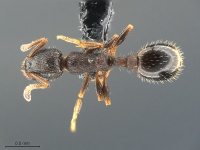Leptothorax crassipilis
| Leptothorax crassipilis | |
|---|---|

| |
| Scientific classification | |
| Kingdom: | Animalia |
| Phylum: | Arthropoda |
| Class: | Insecta |
| Order: | Hymenoptera |
| Family: | Formicidae |
| Subfamily: | Myrmicinae |
| Tribe: | Crematogastrini |
| Genus: | Leptothorax |
| Species: | L. crassipilis |
| Binomial name | |
| Leptothorax crassipilis Wheeler, W.M., 1917 | |
These ants nest in the soil, under stones or rarely in logs and stumps, in sandy loam to rocky loam soils. Brood and reproductives were found in nests from June to August, flights occurred in August. Most nest females are found simply under the stone, one gyne was at a depth of about 10-cm in the soil. This species may be polygynous, as one nest contained 2 dealate females. Colonies were found together with Myrmica hamulata, Camponotus vicinus, Formica lasioides and Formica occulta. (Mackay and Mackay 2002)
| At a Glance | • Tandem running |
Identification
The clypeus of the worker is depressed in the middle and is without a medial carina, although several lateral carinae are present. The propodeal spines are well developed, and thickened at the bases. The anterior face of the petiole meets the dorsum in an angle, the posterior face is convex and rounded. The dorsum of the postpetiole is completely covered with punctate-granulose sculpture. The mesosoma has heavy and dense sculpture. There are numerous long (most over 0.1 mm), pointed (occasionally blunt) tipped hairs. (Mackay and Mackay 2002)
Distribution
United States: Wyoming south to New Mexico, west to Nevada and Arizona. South into Mexico.
Latitudinal Distribution Pattern
Latitudinal Range: 44.59° to 31.910778°.
| North Temperate |
North Subtropical |
Tropical | South Subtropical |
South Temperate |
- Source: AntMaps
Distribution based on Regional Taxon Lists
Nearctic Region: United States (type locality).
Neotropical Region: Mexico.
Distribution based on AntMaps
Distribution based on AntWeb specimens
Check data from AntWeb
Countries Occupied
| Number of countries occupied by this species based on AntWiki Regional Taxon Lists. In general, fewer countries occupied indicates a narrower range, while more countries indicates a more widespread species. |

|
Estimated Abundance
| Relative abundance based on number of AntMaps records per species (this species within the purple bar). Fewer records (to the left) indicates a less abundant/encountered species while more records (to the right) indicates more abundant/encountered species. |

|
Habitat
Oak woodland, deciduous forests, ponderosa pine-riparian, Chihuahua pine, Douglas fir, spruce and fir forests, grasslands, subalpine fir, moist, shaded slopes as well as grassy, level, riparian areas. (Mackay and Mackay 2002)
Biology
Nevada, Wheeler and Wheeler (1986) - We have only 7 records from 4 localities. Two were from the Coniferous Forest Biome. Three nests were under stones.
Castes
Worker
     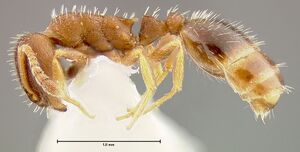  
| |
| . | Owned by Museum of Comparative Zoology. |
Images from AntWeb
   
| |
| Worker. Specimen code casent0104820. Photographer April Nobile, uploaded by California Academy of Sciences. | Owned by UCDC, Davis, CA, USA. |
Queen
Images from AntWeb
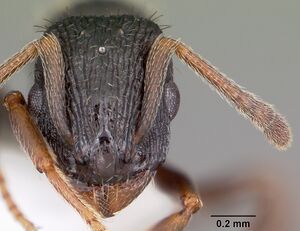 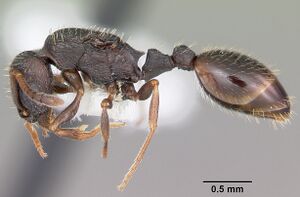  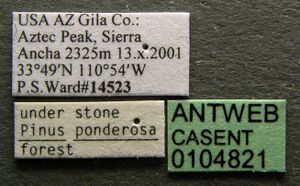
| |
| Queen (alate/dealate). Specimen code casent0104821. Photographer April Nobile, uploaded by California Academy of Sciences. | Owned by UCDC, Davis, CA, USA. |
Nomenclature
The following information is derived from Barry Bolton's Online Catalogue of the Ants of the World.
- crassipilis. Leptothorax (Mychothorax) acervorum subsp. crassipilis Wheeler, W.M. 1917a: 513 (w.q.m.) U.S.A. Raised to species: Creighton, 1950a: 278. See also: Loiselle, Francoeur, Fischer & Buschinger, 1990: 329.
Description
Karyotype
- n = 17 (USA) (Francoeur, 1986; Loiselle et al., 1990).
- n = 18 (USA) (Francoeur, 1986; Loiselle et al., 1990).
References
- Creighton, W. S. 1950a. The ants of North America. Bulletin of the Museum of Comparative Zoology 104: 1-585 (page 278, Raised to species)
- Loiselle, R.; Francouer, A.; Fischer, K.; Buschinger, A. 1990. Variations and taxonomic significance of the chromosome numbers in the Nearctic species of the genus Leptothorax (s.s.) (Formicidae: Hymenoptera). Caryologia 43: 321-334 (page 329, see also)
- Mackay, W. P. and E. Mackay. 2002. The ants of New Mexico (Hymenoptera: Formicidae). Edwin Mellen Press, Lewiston, NY.
- Möglich, M. 1978. Social organization of nest emigration in Leptothorax (Hym., Form.). Insectes Sociaux 25(3), 205–225 (doi:10.1007/bf02224742).
- Wheeler, G. C. and J. Wheeler. 1986. The ants of Nevada. Natural History Museum of Los Angeles County, Los Angeles.
- Wheeler, W. M. 1917a. The mountain ants of western North America. Proc. Am. Acad. Arts Sci. 52: 457-569 (page 513, worker, queen, male described)
References based on Global Ant Biodiversity Informatics
- Allred D. M. 1982. Ants of Utah. The Great Basin Naturalist 42: 415-511.
- Allred, D.M. 1982. The ants of Utah. Great Basin Naturalist 42:415-511.
- Cole A. C., Jr. 1953. Notes on the genus Leptothorax in New Mexico and a description of a new species. Proceedings of the Entomological Society of Washington 55: 27-30.
- Gregg, R.T. 1963. The Ants of Colorado.
- La Rivers I. 1968. A first listing of the ants of Nevada. Biological Society of Nevada, Occasional Papers 17: 1-12.
- Mackay W. P., and E. E. Mackay. 2002. The ants of New Mexico (Hymenoptera: Formicidae). Lewiston, New York: Edwin Mellen Press, 400 pp.
- Mackay, W., D. Lowrie, A. Fisher, E. Mackay, F. Barnes and D. Lowrie. 1988. The ants of Los Alamos County, New Mexico (Hymenoptera: Formicidae). pages 79-131 in J.C. Trager, editor, Advances in Myrmecololgy.
- Wheeler G. C., and J. Wheeler. 1986. The ants of Nevada. Los Angeles: Natural History Museum of Los Angeles County, vii + 138 pp.
- Wheeler G. C., and J. Wheeler. 1987. A Checklist of the Ants of South Dakota. Prairie Nat. 19(3): 199-208.
- Wheeler, G.C. and J. Wheeler. 1978. Mountain ants of Nevada. Great Basin Naturalist 35(4):379-396
- Wheeler, G.C. and J. Wheeler. 1988. A checklist of the ants of Wyoming. Insecta Mundi 2(3&4):230-239

